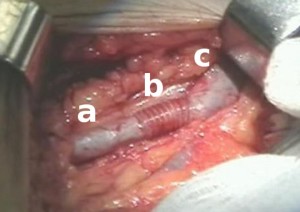In the advent of modern endovenous techniques open venous surgery still has a place in bypassing obstructed veins. The May-Husni procedure is used to bypass an obstructed (superficial) femoral vein by transposing the distal end of the great saphenous vein (GSV) to the popliteal vein. Most of these patients develop obstructive symptoms from a previous deep vein thrombosis. They typically present with venous claudication which is specific for venous obstruction. This is when the venous outflow from the calf is unable to compensate for the increased blood flow during exercise.
EVGENY SHAYDAKOV Selecting patients for a May-Husni procedure (popliteal-femoral bypass) requires a careful history for venous claudication and investigations which reveal obstruction of the femoral vein with preserved patency of the popliteal, common femoral and great saphenous veins. This can be achieved with duplex ultrasound and ascending venography. Patients with post-thrombotic syndrome often have concurrent deep and superficial venous reflux as well as obstruction. Both of these require a careful evaluation to determine which component predominates. Some patients have adequate collaterals from the popliteal vein into the deep femoral vein which is able to compensate for the femoral occlusion. Non-visualisation of the deep femoral vein during ascending venography suggests that these collaterals are absent indicating suitability for a May-Husni procedure. We apply an external helix (Vedensky spiral) to support the GSV which helps maintain competency in this vein, especially since it is required to drain the majority of the leg. Postoperative care includes compression stockings, exercise and anticoagulation for 3 months.
The sapheno-femoral junction acts as the distal end of the popliteal-femoral bypass. (a) GSV, (b) Vedensky spiral, (c) Common femoral vein.
